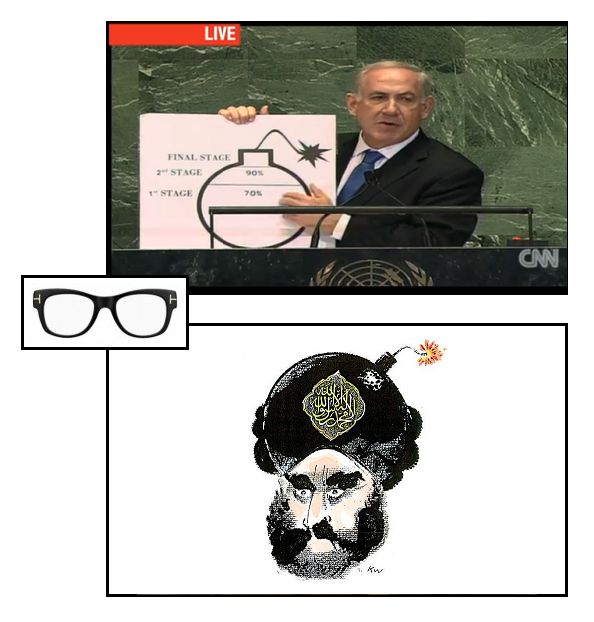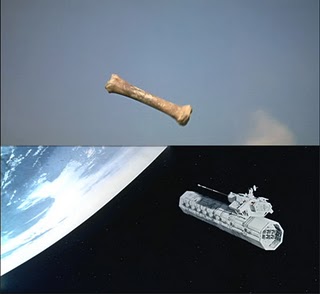Graphic matches?
[ by Charles Cameron — Netanyahu’s UN speech, Jyllands-Posten cartoon, a nifty film technique, and is there an echo there? ]
.
**
A fair number of people have commented on Israeli PM Netanyahu‘s displaying a cartoonish bomb graphic in the course of his UN address today, and some have complained, fairly IMO, at the choice of photo used to depict Netanyahu during his speech by eg Fox News:
I think it’s important to read graphic messages closely for the cues they contain.
**
Sometimes, as with images of the Virgin Mary seen in grilled cheese sandwiches or oil slicks, the correspondences don’t really mean much more than that the brain is designed for pattern recognition, and a little “imagination” without critical appraisal can get things wrong: the terms commonly used for this are apophenia, patternicity and pareidola.
My own favorite example of this phenomenon is of the wall-stain in a school in the East Bay that was recognized as the Virgin Mary by Catholics and the bodhisattva Kuan-Yin by Buddhists…
Nonetheless, I’m reluctant to ridicule such modes of perception without also recognizing the utility of Rorschach blots in psychology and the even more creative uses to which Leonardo put them.
**
Perceived visual similarities, in short, can be the result of creative or merely overheated imagination, but in the visually sophisticated they become much more.
Film-makers, in particular, have several names for the kind of skillful editing by which one scene segues into another via a well-chosen visual similarity: match cut and graphic match.
My personal favorite example is that of Apocalypse Now, where the rotors of the fan in that claustrophobic hotel room in Saigon morph into the rotors of the helicopter coming to take Captain Willard out and away on his mission up river…
Perhaps even more celebrated, though, is Kubrick’s match between the bone tumbling through the air and the space station tumbling through space, in 2001: A Space Odyssey:
**
To get back to Netanyahu, then — is his hand held out a little above vertical, palm down, really a Hitler salute? I think not.
And does his image of a bomb carry any resonance from the Jyllands-Posten cartoon? I have to admit I’m almost undecided on that one.
And if there’s just a hint of a correspondence, would it be conscious or unconscious?
**
The thing is, politicians have to be extremely careful about tossing graphic matches onto dry kindling.
To my own way of thinking, both Netanyahu’s “cartoonish bomb” graphic and his “mid-heil” salute are potential fodder for incautious speculation — but neither one is even remotely as far-fetched as Jerome Corsi‘s claim in a recent WND that a recent Obama campaign use of the Stars and Stripes (above, upper panel) — in admittedly terrible taste — suggests that Obama in any way favored the decease of Ambassador Christopher Stevens in Benghazi (lower panel).
**
My point here, as so often, lies not in any political content or conclusion, so much as in a general purpose invitation to persons of intelligence (and a fortiori, intel) to watch out for possible graphic matches, to make close and cautious readings of visual as well as textual data — in short, to take a closer look…







September 27th, 2012 at 11:29 pm
For those who prefer to compare Netanyahu’s image of the bomb directly with the cartoon, I just ran across the full text of Netanyahu’s speech, and it includes the slide he used. Here’s the direct comparison:
September 28th, 2012 at 1:24 am
What is funny is that they are still using a picture of a type of bomb you aren’t likely to find used anymore. Or maybe I’m just out of the loop.
September 28th, 2012 at 1:43 am
Hi Charles,
.
One reason a picture is worth a thousand words. Our cognitive patterns are susceptible to confirmation bias—so we see what we “know.” Modern communications with high visual content is open to multiple interpretations dependent on the pattern set and values the person brings to the table.